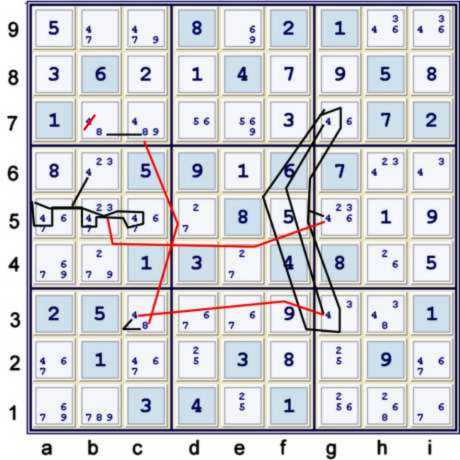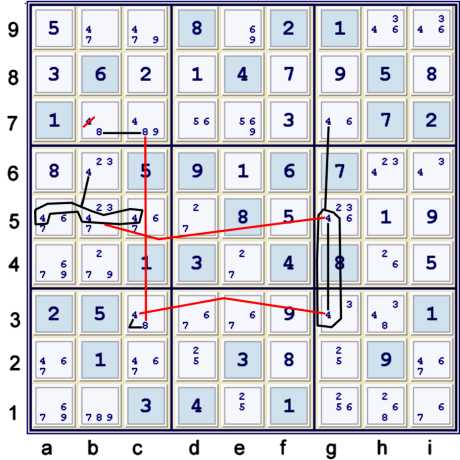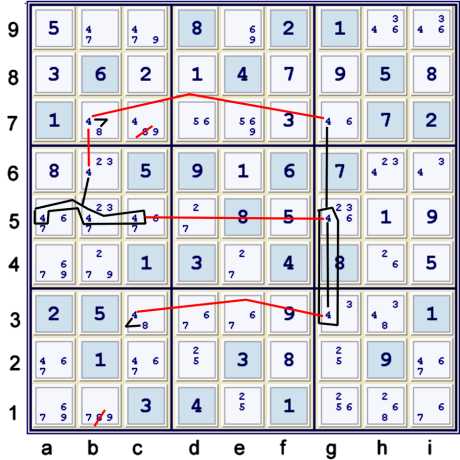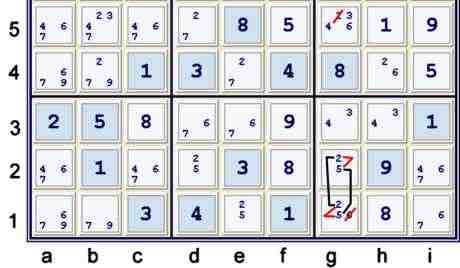Welcome back!
This proof is a total of three pages. Hopefully, you have already digested the
First Page and the
Second Page.
This page is much simpler than the previous two. The puzzle can be solved from here without
Advanced chains, however, I choose to use one such chain, illustrated variously, on this page.
Some locked candidate 9 eliminations

After making the eliminations justified by Locked candidate 9 in box h5, and then those
by the newly locked candidate 9 in column c, three more cells can be solved:
- a8 = 3 %cell
- g8 = 9 %cell&row
- i5 = 9 %box,row,&column
Naked Pair 67

The naked pair 67 at de3 proves the eliminations shown above.
Three ways to view the same step using candidates 4 & 8
All three representations below consider the exact same strong and weak inferences. All of
them are found easily by searching for a very common Y Wing style centered upon c3,b7 both
limited to candidates 48. Since this very common Y wing style does not exist, but one should
look for it given the markers, finding the following chains is fairly routine.
Hinged coloring with 4s appended by a chain piece

Above, one almost has:
- (4):b6=abc5-g5=g7 => b7≠4
- But, (4):g5=g7 is not quite true, so one appends onto that chain:
- =(4)g3-(4=8)c3-(8)c7=(8)b7
- deriving the complete chain:
{(4):b6=abc5-g5=
1g7}=
1(4)g3-(4=8)c3-(8)c7=(8)b7=>b7≠4
Y Wing style appended with a chain piece

Above, one almost has:
- Y wing style using candidates 4&8:
- (8)b7=(8)c7-(8=4)c3-(4)g3=(4)g7=>b7≠4
- But, (4):g3=g7 is not quite true, so one appends onto that chain:
- (4):g5-abc5=b6
- deriving the complete chain:
{(8)b7=(8)c7-(8=4)c3-(4)g3=
1(4)g7}=
1(4)g5-(4)abc5=(4)b6=>b7≠4
Depth 4 bi chain with 48 appended trivially in the result only

Above, the almost chain:
- (8)b7=(8)c7-(8=4)c3-(4)g3=(4)g5-(4)abc5=(4)b6=>b7≠4
- but, (4):g3=g5 is not quite true
- however, the appendage (4)g7 does not change the result since:
- (4):g7-b7
- yielding the easy chain:
{(8)b7=(8)c7-(8=4)c3-(4)g3=
1(4)g5-(4)abc5=(4)b6}=
1(4)g7=>b7≠4
This last representation is a very good example of the power of appending simple chains
derived from the concept of a pigeonhole matrix. If one was to write the
pigeonhole matrix representation, then one would only need to append a bi-matrix in the result
column. Clearly, in this case, the conclusion is not changed.
However, none of these three examples is what I saw first. Instead, I saw the following:
Extended Very common Y wing style appended 3 dimensionally

Above, one almost has a very common Y wing style with a two strong link vertex:
- (8=4)b7-(4)b6=(4)abc5-(4)g5=(4)g3-(4=8)c3=>b1&c7≠8
- But (4):g5=g3 is not quite true
- However, since (4)g7 lies at the intersection of the strong inference 4s in
column g and the weak inference 4s in row 7, by the rules derived from the triangular matrix, we
have:
{(8=4)b7-(4)b6=(4)abc5-(4)g5=
1(4)g3-(4=8)c3}=
1(4)g7-(4=8)b7=>b1&c7≠8
Note that the chain piece:(4):b6=abc5-g5=1g3 can be viewed as a vertex in a very
common Y wing style. Thus, by searching for the very common Y wing style indicated by cells
b7 and c3 both being limited to only 48, one can find this pattern quickly. Of course, one has
to be aware of the fact that the appendage to the pattern, (4)g7 does not change the conclusion
set at all. This truly demonstrates the power of using matrices to understand how to easily
append simple chains. Learning how to do this well makes many complex eliminations much easier
to find and to understand. I suppose the understanding should come first!
Regardless of which of these 4 patterns one might find, the puzzle is advanced identically:
All the remaining 8s are solved.
Hidden Pair 25

Above, the Hidden Pair 25 at g12 justifies the indicated eliminations.
A bilocation wrap around chain

Above, there are probably dozens of ways to continue. The most efficient for me is the
wrap around chain (or continuous AIC) shown. I always enjoy finding such chains, as they often
provide multiple disparite eliminations. One could write the chain above as:
- (3)b5=(3-6)g5=(6)g7-(6)d7=(6-7)d3=(7-2)d5=(2)b5=>
- (3=6)g5 => g5≠4
- (6):g7=d7 => e7≠6
- (6=7)d3, but we already had that
- (7=2)d5, but we already had that
- (3=2)b5 => b5≠47
Locked Candidate 4

Above, (4)h6=i6 => b6≠4. Then, b9 = 4 %column, and the puzzle is reduced to naked
singles to the end.
Solved Puzzle

Some preaching
I hope that it is well understood that the concept of matrices can be a powerful
tool in deriving what simple chain appendages look like. With that understanding, one can
then more easily find the complex chains. Once one can find the complex chains, many truly
problematic puzzles are made much easier.
A note
I am not publishing ratings for a while, as I am thinking of overhauling my rating system. I
would like to attempt to reflect the added complexity of steps that cannot be represented by
a pigeonhole matrix. However, I have not come upon a satisfactory manner to do so. Suggestions
are welcomed!
Some more preaching
Finally, I have chosen to take one step above and present it in 4 different ways. 3 of these
ways use exactly the same strong inferences. It may be helpful to understand that complex chains can
be represented in more than one way with chains. The matrix representation, however, would
remain constant for each. The other representation uses some different strong inferences. It is
often helpful to look for alternative means to prove the same elimination. Why? Because it
teaches one that such alternatives almost always exist. Thus, the ability to find eliminations
can be significantly enhanced, as there are many more possible ways to find them. Looking for
such alternative means towards a proven elimination is, in my opinion, a fantastic way to
teach oneself how to tackle the truly difficult sudoku puzzles.